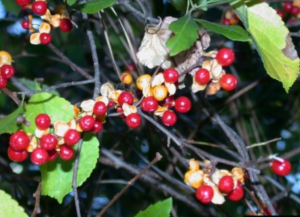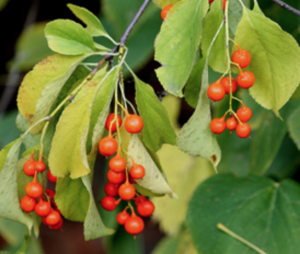Fall decorations are all about pumpkins, chrysanthemums and harvest colors (orange and red). The Bittersweet vine, with its beautiful color, is a ubiquitous symbol of fall. With a little foraging in the woods, lots of folks come home with these berries to add to window boxes, wreaths and seasonal containers.
The problem is that there are two very different varieties of this vine; one good and one very bad.
Asiatic Bittersweet (Celastrus orbiculatus) is highly invasive; twining up and choking trees with its thick, woody vine. Once the berries develop on this vine, any disturbance (e.g. cutting the berries for decoration) can release the seeds and proliferate the growth of new plants. The best ecological practice is to remove Asiatic Bittersweet by hand pulling or cutting, before September. According to the Ecological Landscaping Association you can identify the Asiatic species by its orange roots. Another identifying factor is that the berries of this species grow all along the vine.
 |
| Invasive Asiatic Bittersweet |
American Bittersweet, Celastrus scandens, on the other hand, is a native vine. It can be identified by its berries, which grow in clumps at the end of stems, similar to the way grapes grow. It can still be a rugged vine, so it’s best not to train it to grow up trees. But, trained on a fence or pergola it can be beautiful and ecologically safe.
 |
| American Bittersweet berries growing in clumps |
So, if you are going to decorate this fall with Bittersweet, be careful what you forage for in the woods. If you can find the American species in nature or at your local florist, that’s great! If not, this is one time when it’s ok to buy the fake kind.



